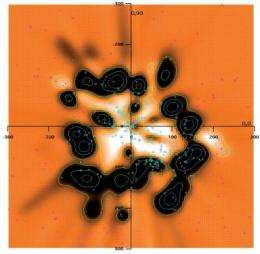A new 3D map of the interstellar gas within 300 parsecs from the Sun

(PhysOrg.com) -- Astronomy & Astrophysics is publishing new 3D maps of the interstellar gas in the local area around our Sun. A French-American team of astronomers presents new absorption measurements towards more than 1800 stars. They were able to characterize the properties of the interstellar gas within each sight line.
This week, Astronomy & Astrophysics publishes new 3D maps of the interstellar gas situated in an area 300 parsecs around the Sun. A French-American team of astronomers presents new measurements of the absorption by the interstellar gas in the Sun's local area. Knowledge of the interstellar medium properties, including the spatial distribution, dynamics, and the chemical and physical characteristics, allow astronomers to better understand the interplay between the evolution of stars and their exchange of matter with the ambient interstellar medium. The local area around our Sun has been studied with many surveys at various wavelengths, but the whole picture is still far from being either complete or fully understood.
The team, led by Barry Y. Welsh and his colleagues R. Lallement and J.-L. Vergely, presents new, high spectral resolution measurements of the calcium (CaII) K line (at 3933 Ĺ) and the sodium doublet (at 5889 and 5895 Ĺ). These absorption lines have long been used to study the interstellar medium. The CaII K lines were first observed in 1904 by German astronomer J. Hartmann, in the spectrum of the star δ Orionis. This first detection of interstellar gas set the stage for the early studies of interstellar medium. The sodium (NaI) doublet was later discovered in 1919 toward δ Orionis and β Scorpii. The CaII K line and the NaI doublet are complementary: the first one is sensitive to partially ionized gas, and the second one traces cold and neutral interstellar gas.
The team combined their new data (mostly recorded at the European Southern Observatory in Chile) with previously published results. The new paper represents a catalog of absorption measurements towards 1857 stars located 800 parsecs from the Sun. Figure 1 shows the NaI map of the interstellar gas density within 300 parsecs. The white area surrounding the Sun (i.e., at the center of the map) corresponds to a very low-density area of neutral gas, known as the Local Cavity. It is about 80 parsecs in radius in most directions and is surrounded by a highly fragmented "wall" of dense neutral gas. The various gaps in the wall are termed "interstellar tunnels" and represent rarefied pathways into other surrounding interstellar cavities. Maps of the distribution of CaII have never been made before, and they reveal that the Local Cavity contains numerous filamentary structures of partially ionized gas that appear to form in a honeycomb-like pattern of small interstellar cells.
Theories of the general interstellar medium require that large rarefied cavities exist, having been formed by the combined action of energetic supernova events and the outflowing winds of clusters of hot and young stars. The history of our Local Cavity, within which the Sun resides, is still speculative, but many believe that it was created about 15 million years ago by a series of supernova outbursts, with the last re-heating happening about 3 million years ago.
More information: New 3D gas density maps of NaI and CaII interstellar absorption within 300 pc, by B. Y. Welsh, R. Lallement, J.-L. Vergely, and S. Raimond. To be published in Astronomy & Astrophysics, 2010, vol. 510, A54. www.aanda.org/10.1051/0004-6361/200913202
Provided by Astronomy & Astrophysics



















